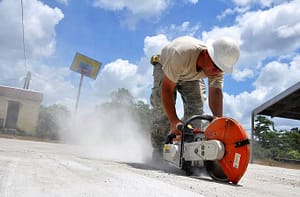It’s generally best to cut concrete within the first 24 to 48 hours after it’s poured, before it fully hardens.After that, it can become increasingly difficult to cut without causing cracks or other damage. However, the exact timeline for when it’s too late to cut concrete depends on various factors, such as the type of concrete, the temperature and humidity conditions, and the purpose of the cut. It’s important to consult with a professional or refer to industry standards to determine the optimal time for cutting your specific project.
The reason is that concrete has a high moisture content which makes it very soft and easy to cut.
It also has a low density which means if you are cutting through hard surfaces such as bricks, concrete or marble then you need to use special tools and techniques.
It depends on the concrete. For example, if you have a concrete driveway that has been put in several weeks ago, then it is unlikely that you will be able to cut it with just a few strokes of the blade. The reason for this is that the concrete has hardened and become very tough. You would need a lot more force to cut through it than normal.

If you are trying to cut through a slab of concrete that has been laid recently or within the last few weeks then there is no problem at all. It will be extremely easy for you to cut through the concrete with just one or two strokes of your blade.
Concrete generally gains its strength after 28 days it will be very tough to cut it with a masonry saw. However, if you have a diamond blade in your masonry saw, you can use this to cut the concrete. The diamond blade is made up of diamonds, which are hard and sharp. It can cut through any material like a knife through butter.
The only disadvantage of using a diamond blade is that it has its own limitations. Firstly, it cannot cut as deep as a regular masonry saw would be able to do. Secondly, it might not be able to cut through all types of concrete as well.
If you are trying to save money on your masonry project by using an alternative method for cutting the concrete then there are plenty of other options available for you which will help save time and money on this type of work!
We know that sometimes, you are stuck with a project which calls for concrete cutting. But using regular blades for this purpose won’t really work if you need a fast and effective way to finish the job. This is where diamond blades can help. They cut through concrete quickly and easily without a lot of hassle. However, not all diamond blades are created equal, so it is important to know what to look for in the best type of blade for your needs. We’ll cover that now.
Here are some blades to cut concrete you can use.
Concrete Cutters – These are the best cutting blades for cutting concrete. They have a sharp blade and a pointy end, which makes it easier to cut through the concrete. These are also long lasting and durable, so you don’t have to worry about replacing them too often.
Metal Blades – A metal blade is another option for cutting concrete that works well if you want to cut small pieces of concrete at once. They will not dull quickly like other types of blades, which makes them ideal for projects that require repeated use or jobs where you need to make multiple cuts in a row.
Hacksaws – Hacksaws are similar to metal blades, but they have serrated edges instead of straight edges like a knife does. This makes them ideal for cutting through thicker pieces of concrete without having to keep adjusting your angle or applying more pressure on your tool as you go along.
Flooring Saw Blade – This is a small circular saw with a blade that is made to cut through flooring. You can use it to cut tile and harder surfaces like concrete. It has a fine tooth blade, so it will not scratch up your walls or floors.
Concrete Saw Blade – These blades have teeth on them that will cut through hard surfaces like concrete without scratching the surface. They are very powerful, so you don’t have to go very far into the concrete before it starts cutting through. They also have a lot of flexibility in their design, so they can be used for cutting many different types of materials in your home or business.
Tile Saw Blade – Tile saw blades are similar to flooring saw blades but they are smaller and meant for cutting ceramic tile instead of hard surfaces such as concrete or marble tile. They have teeth on them that work just like the teeth on a flooring saw blade, but they are much finer and more accurate than those found on a flooring saw blade because they were designed specifically for cutting ceramic tiles instead of hard surfaces such as concrete or marble tile
How to make saw cuts in concrete
Saw cutting can start from 3 to 6 hrs after the concrete has been poured. This is because the concrete needs time to dry out and harden. The sawing process starts with a jackhammer that breaks up a small amount of concrete. It is then transported to the sawing machine, which uses an electric or pneumatic drill to make two parallel cuts into the concrete wall. The cuts are then filled with grout, which holds them together until they are covered with stucco or plaster.
After saw cutting is complete, stucco or plaster will be applied over the cuts and joints. If a stucco or plaster finish is desired, it should be applied at least 30 hours after saw cutting has started.
you can also read: Minecraft bedrock
How Long Can You Leave Concrete Without Cutting It?
Several key factors influence the ideal time to cut concrete. These factors can vary depending on the nature of the project and the specific conditions. Let’s explore the most significant factors impacting cutting time:
1. Weather Conditions:
Weather conditions, such as temperature and humidity, greatly affect the curing process of concrete. High temperatures, for instance, accelerate the curing process, while colder temperatures slow it down. It’s important to consider these factors when determining the appropriate cutting time for your concrete structure.
2. Type of Concrete:
Different types of concrete have varying curing times. Ordinary Portland cement (OPC) concrete, for example, typically reaches its desired strength within 28 days, while fast-setting concrete can achieve similar strength within a few hours. The type of concrete used in your project will play a role in determining the optimal cutting time.
3. Thickness of Concrete:
The thickness of the concrete also affects the cutting time. Thicker sections require more time to cure completely and reach the necessary strength. It’s important to take into account the thickness of the concrete when planning your cutting schedule.
4. Concrete Mixture:
The specific mixture of concrete used can impact the curing time. Factors such as the water-cement ratio and the use of additives can affect the overall strength development and the time it takes for the concrete to mature. Understanding the composition of your concrete mixture is crucial for determining the appropriate cutting time.
5. Reinforcement:
Concrete structures often include reinforcement, such as steel bars or mesh, to enhance their strength and durability. The presence of reinforcement can influence the timing for cutting. It’s important to consider the impact of reinforcement when deciding on the ideal cutting time.
Recommended Cutting Time for Different Scenarios:
While the optimal cutting time may vary depending on the specific project and its conditions, here are some general guidelines for different scenarios:
Residential Projects: Cut Concrete Easily
In residential projects, where the concrete is typically not load-bearing, cutting can generally be done after the concrete has reached its initial set. This usually occurs within 24 to 48 hours after pouring. However, it’s essential to consider the factors mentioned earlier and consult with professionals to determine the ideal cutting time for your particular project.
Commercial Projects:
Commercial projects often involve larger concrete structures and may require more time for the concrete to reach sufficient strength. Typically, cutting can be performed within 3 to 7 days after pouring, depending on the factors influencing curing time. It’s crucial to carefully assess the concrete’s strength before initiating the cutting process to avoid any structural compromises.
Infrastructure Projects:
Infrastructure projects, such as bridges, highways, and large-scale constructions, have specific requirements for cutting time. These projects often involve reinforced concrete and require longer curing periods. Depending on the project specifications and concrete mix, cutting is usually performed after 7 to 14 days. It’s important to consult with engineers and professionals specialized in infrastructure projects to determine the optimal cutting time. cut concrete
Consequences of Delaying Concrete Cutting:
Delaying concrete cutting can have several negative consequences, affecting both the safety and cost-effectiveness of a project. Let’s explore some of the potential consequences of failing to cut concrete in a timely manner:
Safety Concerns:
Concrete structures that have not been properly cut can pose safety hazards. For example, sharp or uneven edges can cause injuries to workers or passersby. Additionally, delayed cutting may hinder the installation of crucial utilities or prevent optimal access to required areas, compromising safety protocols.
Structural Damage:
Cutting concrete at the wrong time or neglecting to cut it altogether can result in structural damage. As concrete cures and strengthens, it develops internal stresses. If these stresses are not relieved through timely cutting, they can lead to unintended cracks, compromised load-bearing capacity, or uneven settlement, jeopardizing the structural integrity of the concrete.
Cost Overruns:
Delaying concrete cutting can lead to cost overruns in construction projects. Necessary modifications or repairs due to improper cutting can be time-consuming and expensive. Moreover, delayed cutting can cause project delays, resulting in increased labor costs, equipment rental fees, and construction schedule revisions.
Project Delays:
Proper planning and timely execution are crucial in construction projects. Delaying concrete cutting can cause a domino effect, leading to delays in subsequent construction activities. This can disrupt the overall project timeline, creating complications and setbacks that impact all stakeholders involved.
Expert Tips for Efficient Concrete Cutting:
To ensure efficient and successful concrete cutting, here are some expert tips to consider:
1. Planning and Scheduling:
Thorough planning is key to cut concrete. Take into account all the factors that might influence curing time and cutting, such as weather conditions, concrete mix, and project specifications. Develop a detailed schedule that allows for optimal cut concrete at the right time.
2. Equipment Selection:
Choose the right equipment for your concrete cutting needs. Whether you’re using diamond blades, saws, or wall saws, ensure they are suitable for the thickness and type of concrete. Proper equipment selection ensures precise cuts, reduces project time, and minimizes potential damage.
3. Hiring Professional Services:
While DIY enthusiasts can tackle some smaller concrete cutting jobs, it is often best to hire professional concrete cutting services, especially for larger or more complex projects. Professionals have the expertise, experience, and specialized equipment required to ensure accurate and efficient cutting while adhering to safety standards.
4. Regular Maintenance:
Maintain your cutting equipment regularly to ensure optimal performance. Dull blades or faulty tools can compromise the quality of the cuts and potentially damage the concrete. Regular maintenance of your cutting equipment not only enhances safety but also prolongs the lifespan of the tools.


1 thought on “when is it too late to cut concrete”